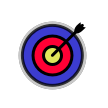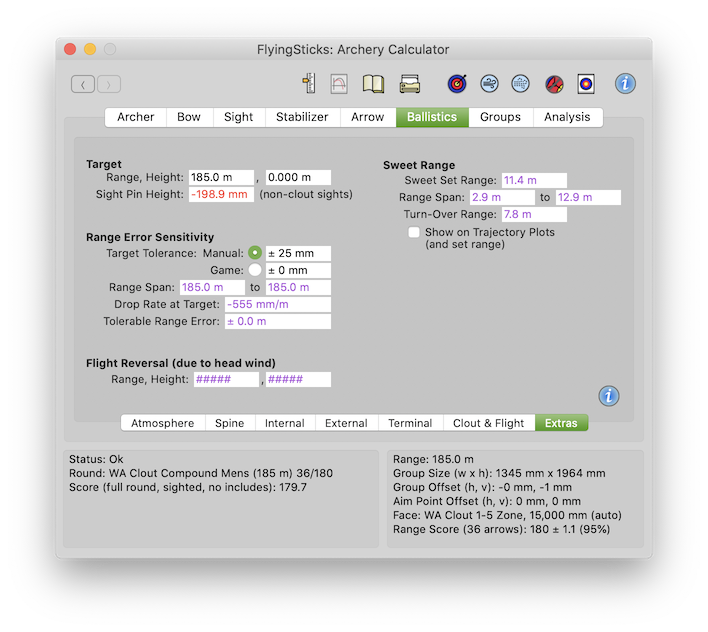 button.
button.A collection of parameters that don't fit comfortably elsewhere.

Enter the desired range here. When the range is set here (as opposed to other places) the target will be automatically re-sighted.
Note that this field may be set automatically when changing the round type in Groups>Round.
Enter target height relative to ground where the archer is standing. In general, this should be no greater that the range (a ±45° sight-line elevation) otherwise the ballistic algorithms may have difficulty in finding a solution.
As for the range field, when the height is set here (as opposed to other places) the target will be automatically re-sighted.
The target height is used for many purposes, however when used for sweet range determination (below) and sight-tape generation (Sight>Tape) the height is first tested. When less than 0 or greater than 3.0 meters, a figure of 1.3 meters is used. This is indicated by the field turning red.
The impact of target height can be noticeable in more extreme circumstances. For example in a trajectory plot with sweet-range showing the, the intercept with the sight-line zone will be seen to move a little due approximations made to reduce the computational load when the target height is reduce to zero.
If the bow is fitted with a sight, then Sight Pin Height shows the current pin height above the arrow center line. Unlike the figures in the Sight>Geometry panel and the tape views, this figure includes current conditions of wind, range and target height.
The field is shown in red if the height is below the minimum safely allowed in Sight>Geometry:Minimum Pin to Arrow Axis.
For clout and flight archery, the height is the uncorrected for the sight's optical offset, so the pin can be significantly below the arrow.
As the range increases, the arrow approaches the target at an increasing angle to the horizontal. This reduces the allowable range estimation error to achieve the required Target Tolerance.
Should any fields show "######" then re-sight the target using the  button.
button.
The target tolerance is the distance an arrow can be from an aiming point on the target and still be considered to have hit that point. It excludes arrow diameter (line-cut) and group spread due to archer's form, wind or any other effects. It can be set in two ways:
Manual:
|
Indicates the minimum and maximum range for the current shot to be on target within the above Target Tolerance. When the range is close to the sweet range (below) the minimum may not include the extended range due to the multiple crossings of the sight-line. Reducing the range a little should see the minimum figure jump to a significantly lower value, close to the sweet range minimum.
The amount of arrow fall per unit of range traveled. Gives a "feel" for the importance of accurate range estimation.
The range tolerance for which the arrow will strike target within the above specified Target Tolerance. Requires that the kit be re-sighted, otherwise shown as undefined.
When the trajectory includes the "Sweet Range" effect the value is no longer centered on the target range.
In the presence of a strong head wind, it is possible that an arrow reverses its direction. This field indicates the height above ground and range that the reversal has occurred. "####" indicates no reversal.
Playing with strong head winds and high launch elevations can create some interesting flight paths - some dangerous to the archer and observers.
Theoretically, purpose designed arrows could move in a more circular path, however the aerodynamics of such arrows is not modeled by FlyingSticks
The range "sweet spot" is a nominal sight set point that caters for the widest range span for a given target tolerance. It is useful for quick response shooting when there is little time to consider ranging issues as in some 3D shoots, moving targets and small game hunting.
The sweet spot is established when the sight-line (i.e. the line between eye and target) intersects the arrow's ballistic path at two points. The target tolerance determines the peak ballistic path to sight-line height between the two intersection points. The sight must be enabled in Bow>Model and a non-clout sight selected in Sight>Model for the fields to be valid.
If the "Target Height" (above) is set between 0 to 1.5 m, that height is used; otherwise the default of 1.3 m is applied.
Setting the sight range to this point will ensure all ranges between the Minimum Range and Maximum Range will strike the target within the Target Tolerance. This range is marked as a solid circle on the sight tape reticle if the appropriate checkbox is checked.
Calculated minimum and maximum range where the arrow will strike target within the tolerance specified.
Note: the sweet range span is calculated for the current target height - which can significantly affect the result.
This is the range at which the sight pin height reverses due to the interaction of the sight geometry and the parabolic trajectory path. This usually occurs at ranges of 8 to 15 m (8 to 15 yd). It is shown as a horizontal line on the sight-tape reticle. Note that this is calculated for the current target height - it is slightly dependent on target height.
Any visible trajectory plots will show two vertical lines that are the bounds of the sweet range. Same action as the Sweet Range checkbox on the Ballistics>Internal panel.